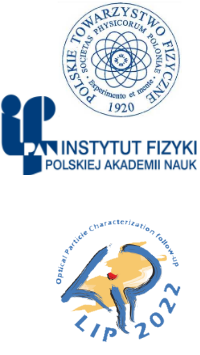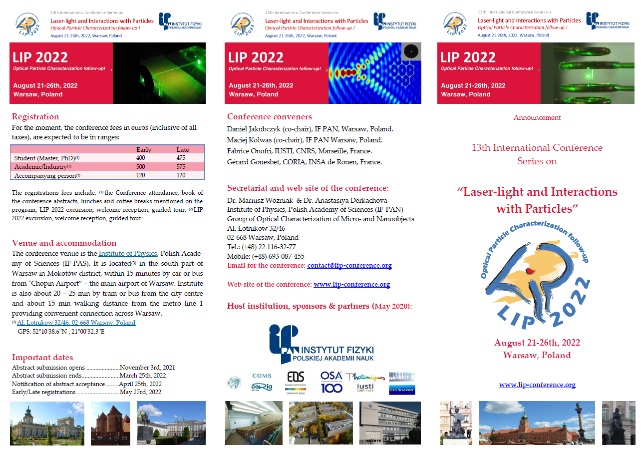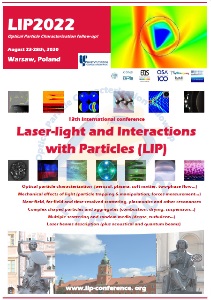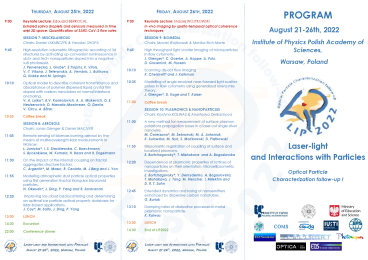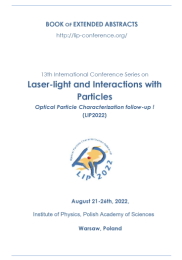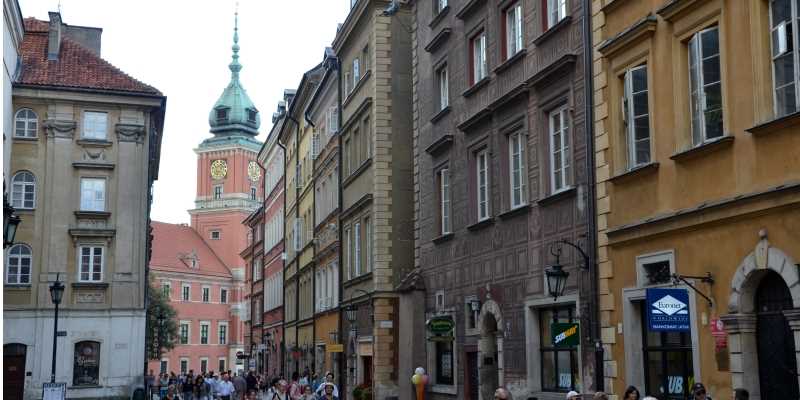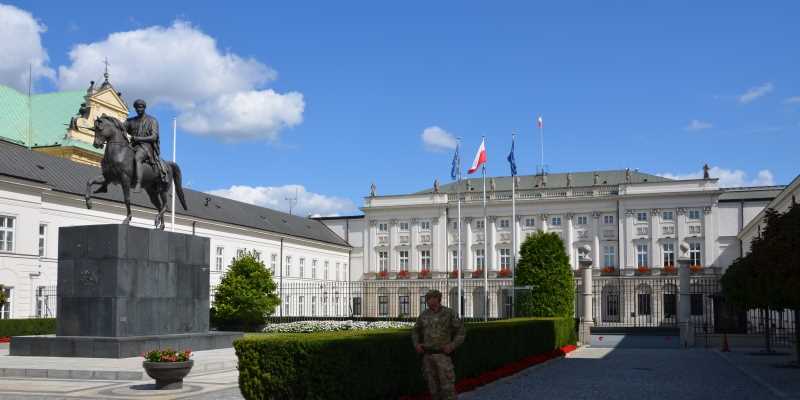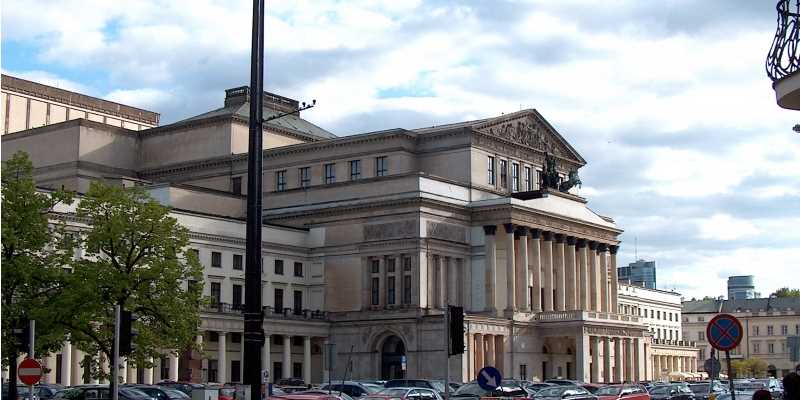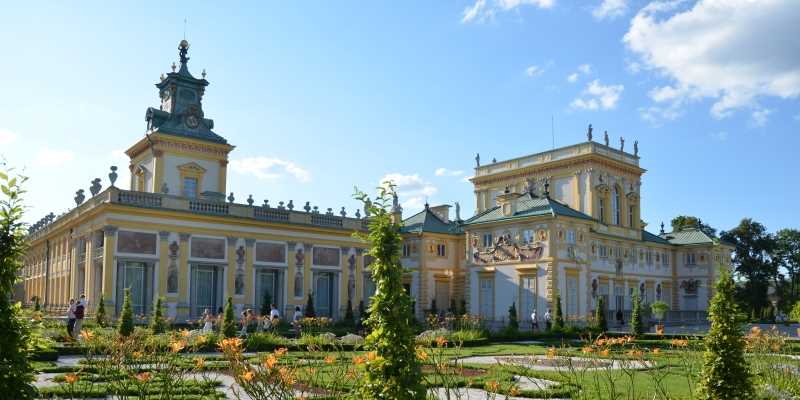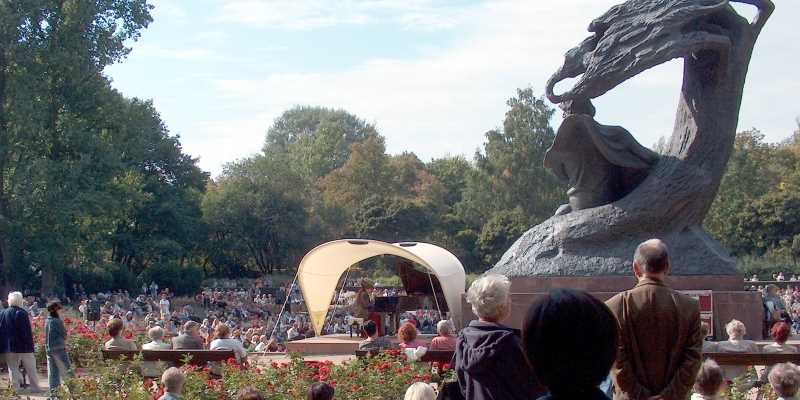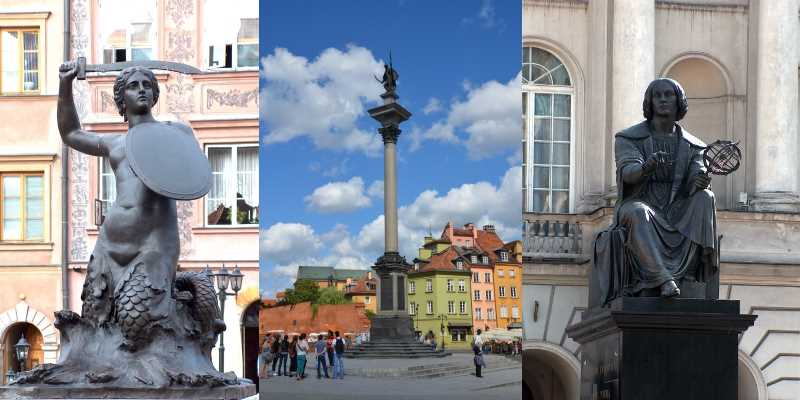Scope & Background
-
- Scope of LIP conferences
- LIP2022: flyer and posters
- Previous LIP, OPC & OPS conferences...
The 13th international
conference series on Laser-light and Interactions
with Particles (LIP) - Optical Particle Characterization
follow-up ! is organized at the Institute of
Physics of the Polish Academy of Sciences (IPPAS) on
August 21-26th, 2022, Warsaw, Poland. Due to
possible travel restrictions during this summer, the
conference will be an hybrid, mixing traditional
in-person and remote participations (via video
conferencing).
The conference is focused on interactions between laser beams and particles, from theory to practice (download the flyer), encompassing in particular the following fundamental topics :
The conference is focused on interactions between laser beams and particles, from theory to practice (download the flyer), encompassing in particular the following fundamental topics :
-
particle characterization methods (interferometric,
polarimetric, spectral, static, dynamic...),
- near-field, far-field and time-resolved scattering (computations, laboratory experiments...)
- plasmonics, other resonances and caustics (probing, scattering enhancement, modelling...)
- complex shaped particles and aggregates (morphology, composition, functionalization...)
- multiple scattering and random media (dense, turbulent,...)
- mechanical effects of light (particle manipulation, force measurement, optical tweezer...)
- laser beams description (contributions acoustical and quantum beams are also welcomed).
and application domains: - near-field, far-field and time-resolved scattering (computations, laboratory experiments...)
- plasmonics, other resonances and caustics (probing, scattering enhancement, modelling...)
- complex shaped particles and aggregates (morphology, composition, functionalization...)
- multiple scattering and random media (dense, turbulent,...)
- mechanical effects of light (particle manipulation, force measurement, optical tweezer...)
- laser beams description (contributions acoustical and quantum beams are also welcomed).
- two-
and multiphase flow characterization ( combustion, spray,
bubbly flow...),
- aerosol and atmospheric sciences (nucleation, transport, characterization...),
- plasma and soft matter physics (nanocristallite, Coulomb crystal, colloids, suspensions, aggregation, ,...),
- biomedical optical engineering (cell manipulation and properties, microrheology...),
- remote sensing and free space communication (holography, lidar, turbulence...).
- aerosol and atmospheric sciences (nucleation, transport, characterization...),
- plasma and soft matter physics (nanocristallite, Coulomb crystal, colloids, suspensions, aggregation, ,...),
- biomedical optical engineering (cell manipulation and properties, microrheology...),
- remote sensing and free space communication (holography, lidar, turbulence...).
This conference series has
been continually providing forums for promoting the
interchange of new ideas on the development of advanced
theories and models, as well as the latest experimental
developments. Since nearly three decades
this series, whose topics are continuously evolving,
provides a source of state-of-the-art in
light and shaped beam interactions with particle and
particle systems. The present edition follows the former
Optical Particle Sizing (OPS) and Optical
Particle Characterization (OPC) conferences held
in Rouen
1987; Tempe,
AZ, 1990; Yokohama, 1993; Nürnberg,
1995; Minneapolis, MN,1998; Brighton,
2001; Kyoto,
2004; Graz, 2007 as well as the reformulated LIP
conference, held in Rouen
in 2012; Marseille, 2014; Xi'an 西安市, 2016 and
College Station (TX) in 2018. The 13th LIP
conference, initially scheduled in 2020, was postponed to
2022 due to the covid-19 pandemic, but the special issue was
maintained!
Find detailed information (and papers) on the previous websites of LIP conferences :
Over the years, selected papers from this conference series were published in books and special issues of highly ranked journals (Applied Optics, Particle & Particle Systems Characterization, Journal of Quantitative Spectroscopy & Radiative Transfer), e.g.
Find detailed information (and papers) on the previous websites of LIP conferences :
 |
 |
 |
 |
| LIP2012 |
LIP2014 |
LIP2016 |
LIP2018 |
Over the years, selected papers from this conference series were published in books and special issues of highly ranked journals (Applied Optics, Particle & Particle Systems Characterization, Journal of Quantitative Spectroscopy & Radiative Transfer), e.g.
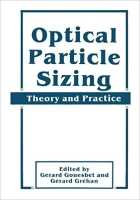 |
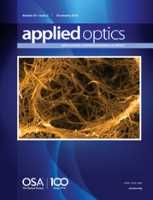 |
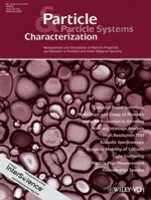 |
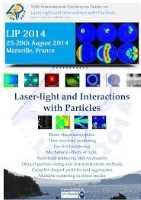 |
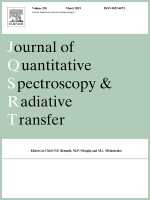 |
| OPS1987... |
OPS1991... |
OPC1996... |
LIP2014... |
...LIP2020 |
Committees, sponsors & partners
-
- Scientific Committee
- Advisory committee
- Conveners & local committee
- Partners & Sponsors
W. Bachalo , Artium technologies Inc, CA, Sunnyvale, USA-
X.S. Cai , University of Shanghai for Science and Technology, Shanghai, China -
Y.P. Han , School of Science, Xidian University, Xidian, China -
G. Gouesbet, CORIA, National Institute of Applied Sciences, Rouen, France -
G. Gréhan , CORIA, National Center for Scientific Research, Rouen, France J.A. Lock, Cleveland State University, Cleveland, OH, USA.-
O. Maragò , IPCF, National Research Council, Messina, Italy -
P.L. Marston , Depart. Physics & Astronomy, Washington State University, Pullman, USA -
M. I. Mishchenko , NASA Goddard Institute for Space Studies, New York, NY, USA -
F.R.A. Onofri , IUSTI, National Center for Scientific Research, Marseille, France -
C.M. Sorensen , Physics Department, Kansas State University, Manhattan, KS, USA B. Stout , Fresnel Institute, Aix-Marseille University, Marseille, FranceC. Tropea , SLA, Technical University of Darmstadt, Darmstadt, Germany.G. Videen , Army Research Laboratory, Adelphi, MD, USAT. Wriedt , ITW, University of Bremen, Bremen, Germany-
Z.S. Wu , School of Science, Xidian University, Xidian, China -
P. Yang , Dept. Atmospheric Sciences, Texas A&M University, College Station, TX, USA
-
Y. Aizu , Muroran Institute of Technology, Muroran, Japan -
L. A. Ambrosio , University of Sao Paulo, USP, Brazil M. Brunel , Laser/particle(s) interaction, CORIA, Normandy University, Rouen, FranceR. Chakrabarty , Division of Atmospheric Sciences - Desert Research Institute, Reno, USAL. Tsang , Dept. Electr. Eng. and Computer Sci., University of Michigan, MI, USAY.E. Geints , Zuev Institute of Atmospheric Optics, Russian Academy of Sciences, Tomsk, Russia-
D. Grier , Department of Physics and Center for Soft Matter Research, New-York University, New-York, USA -
S. Hanna , Nanophysics and Soft Matter, University of Bristol, Bristol, UK M. Kolwas , Institut of Physics, Polish Academy of Sciences, Warsaw, Poland-
F. Lemoine , Spray combustion and optical diagnostics, LEMTA, University of Lorraine, Nancy, France F. G. Mitri , Chevron, Area 52 Technology, Santa Fe, NM, USAA.A.R. Neves , Federal University of ABC, Santo André, BrazilT. Nieminen , Dept. of Physics, University of QueenslandBrisbane, AustraliaB. Pouligny ;, CRPP, National Center for Scientific Research, Pessac, FranceH.-H. Qiu , Dept. Mech. Engineering, Hong Kong University of Science & Technology, Kowloon, Hong Kong-
K-F. Ren, Laser sources and dense media diagnostics, CORIA, Normandy University, Rouen, France N. Roth , Institute of Aerospace Thermodynamics, Stuttgart University , Stuttgart, Germany-
M. Šiler , Institute of Scientific Instruments of the ASCR, Brno, Czech Republic -
A.M.K.P. Taylor , Department of Mechanical Engineering, Imperial College, London, UK -
X.M. Sun , School of Electrical and Electronic Engineering, Shandong University of Technology, Zibo, China M.R. Vetrano , Department of Mechanical Engineering, KU Leuven, Leuven, BelgiumJ. J. Wang , School of Science, Xidian University, Xi’an, ChinaS. Will , Friedrich-Alexander-Universität, Erlangen-Nürnberg, LTT, Erlangen, GermanyF. Xu , The University of Oklahoma National Weather Center, Norman, USAR. Xu , Micromeritics Instrument Corp., Shanghai, ChinaM. Yurkin , Voevodsky Inst. of Chem. Kinetics and Comb., Novosibirsk, Russia
Conference converners:
-
Daniel Jakubczyk (co-chair) , IP-PAS, Warsaw, Poland -
Maciej Kolwas (co-chair), IP-PAS, Warsaw, Poland -
Fabrice Onofri, IUSTI, CNRS, Marseille, France -
Gérard Gouesbet, CORIA, INSA de Rouen,Saint-Etienne du Rouvray, France
-
Anastasiya Derkachova, IP-PAS, Warsaw, Poland -
Gennadiy Derkachov, IP-PAS, Warsaw, Poland -
Krystyna Kolwas, IP-PAS, Warsaw, Poland -
Slawomir Palesa, IP-PAS, Warsaw, Poland -
Yaroslav Shopa, IP-PAS, Warsaw, Poland -
Mariusz Wozniak, PIT-RADWAR S.A., Warsaw, Poland
List (August, 2022) - be one of them (contact us!)

- French Association for the Promotion of Laser Techniques (AFVL)
- Conference Management Software (COMS Optics and Lasers)
- Electromagnetic and Light Scattering by Particles Newsletter (ELS Newsletter)
- Institute of Physics (IF-PAN)
- Laboratory CORIA, UMR 6614, CNRS, INSA Rouen & Normandy University
- Laboratory IUSTI, UMR 7343, CNRS
& Aix-Marseille University
- Light Scattering Information Portal for the light scattering community (SCATTPORT)
- Photoniques
- European Optical Society (EOS)
- European Physical Society (EPS)*
- Optical Society of America (OSA)
- Polish Physical Society (PPS)
- Co-funded by the
'Excellent Science' program of the Polish Ministry
of Education and Science
Keynote lectures
-
- Leonardo Ambrosio
- Edouard Berrocal
- David Grier
- Monika Ritsch-Marte
- Maciej Wojtkowski
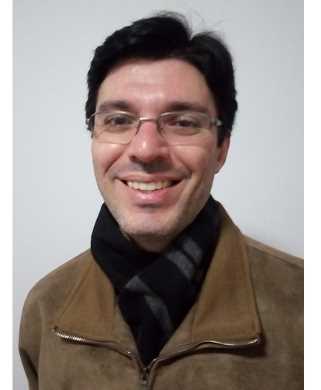 |
|
| Department of Electrical and Computer Engineering, University of São Paulo, Brazil | |
| “Structured fields constructed from superpositions of nondiffracting beams” | |
| In this talk a new technique for creating linear, superficial or volumetric nondiffracting beams and pulses is presented. Constructed from discrete or continuous superpositions of arbitrary-order Bessel beams, it allows both the theoritician and the experimentalist to conceive, design and produce arbitrary-shaped, diffractionless and even dispersion-free structured light fields along lines, surfaces and volumes, even in lossy and dispersive media. Although of wide range of applicability in telecommunications, remote sensing, optical alignment, atom guiding and so on, here we focus on applications in optical manipulation of micro-sized particles and on examples which can be of great interest in volumetric or holographic displays. A historical perspective on the calculation of the beam shape coeffcients of such beams is presented in terms of the recent challenge of finding reliable descriptions of Bessel beams in the context of the generalized Lorenz-Mie theory and with the aid of localized approximation schemes. |
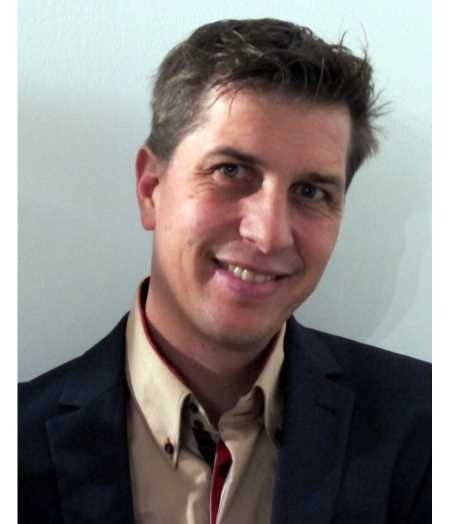 |
|
| Spray-imaging group, Combustion Physics, Lund University, Sweden | |
| “Exhaled saliva droplets and aerosols measured in time and 3D space: Quantification of SARS-CoV-2 flow rates ” | |
| Understanding the airborne transmission of pathogens, such as SARS-CoV-2, requires accurate measurements of the exhaled particles. This presentation describes how the size and velocity of the ejected saliva droplets and aerosols can be measured near the mouth. These measurements have been applied when speaking and coughing. The tracking of each detected particle has been achieved in 3D at 15 000 images per seconds. The sizing of the particles has been reached using laser light scattering detected in the semi-forward direction. The evaporation of water content in the particles is analyzed to deduce the transition from saliva droplets to solid aerosols. Using the measured volume of the particles ejected over time, together with a concentration of SARS-CoV-2 in saliva, an estimation of the flow rate emission of virions has been deduced. |
 |
|
| Department of Physics and Center for Soft Matter Research, New-York University, USA | |
| “Holographic Particle Characterization: Unveiling the Composition and Dynamics of Colloidal Dispersions with Holographic Video Microscopy” | |
| The
in-line hologram of a micrometer-scale colloidal
particle encodes extensive information about the
particle's three-dimensional position, its size,
its shape and its material composition.
One snapshot can localize a colloidal sphere to
within one or two nanometers over a range of
hundreds of micrometers. The same analysis
yields the sphere's diameter to within a few
nanometers and its complex refractive index to
within a few parts per thousand. No other
single technique provides such a wealth of
particle-resolved information, especially for
undiluted and heterogeneous dispersions.
Implementations based on the Lorenz-Mie theory
of light scattering can analyze dozens of
holograms per second on standard computer
workstations. This is fast enough to
provide feedback for colloidal synthesis
reactions and to control industrial processes.
Machine-learning implementations are a dozen
times faster. We will demonstrate these
capabilities in applications ranging from
time-resolved analysis of single-particle
transformations to real-world applications in
biopharmaceutical manufacturing and
semiconductor processing. |
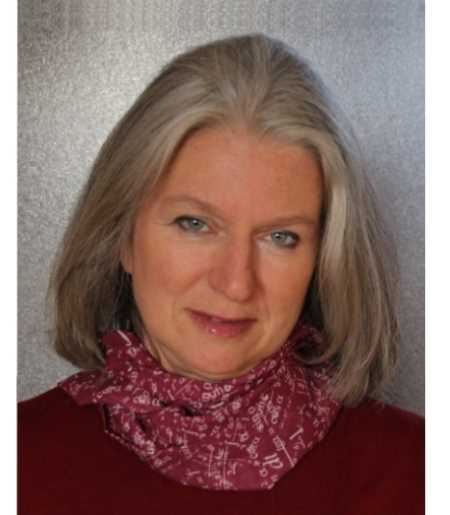 |
|
|
| Biomedical Optics, Medical University of Innsbruck, Austria | ||
| “Tailored optical and acoustic traps for organoid research” | ||
| Optical
imaging of trapped bio-samples poses a serious
challenge for large living specimens, such as
developing embryos organoids. A customized combination of optical tweezers and standing ultrasound waves represents a flexible solution to this problem, facilitating 3D-manipulation and volumetric imaging |
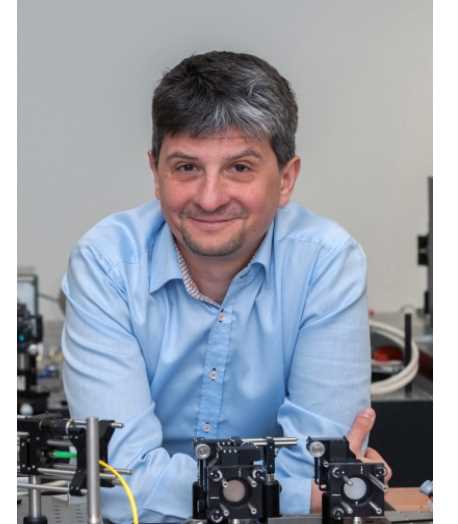 |
|
|
Institute
of Physical Chemistry, Polish Academy of
Sciences, & International Center for Translational Eye Research (ICTER), Poland |
|
|
In vivo imaging by Spatio-Temporal
Optical Coherence techniques |
|
| The main physical limitation of the in vivo microscopic imaging is associated with light scattering introduced by irregular and often discontinuous distribution of refractive index. Scattering of light limits the number of ballistic photons delivered to and received from the sample. In our work we try to solve these fundamental physical limitations by developing new optical coherence imaging techniques, which utilize spatio-temporally partially coherent light with access to intensity and phase of detected radiation. In our research activity we focus on developing new optical methods that enable to image biological objects in vivo and in minimally invasive way. We went long way covering significant spectrum of various sizes of objects – from organ-size scale up to internal structure of a single cell. |
Program
- Program & book
- Monday, 22th
- Tuesday, 23th
- Wednesday, 24th
- Thursday, 25th
- Friday, 26th
|
YouTube : |
https://youtu.be/Dwl5L1pEYNo |
| 7h30 | |
| 8h30 |
|
| 9h00 |
|
| |
STRUCTURED
FIELDS CONSTRUCTED FROM SUPERPOSITIONS OF
NONDIFFRACTING BEAMS |
| 9h45 |
|
| |
Chairs: Fabrice ONOFRI & Huan TANG |
| |
(BE-1)
DIVERGING AND CONVERGING SCHEMES OF
APPROXIMATIONS FOR GAUSSIAN BEAMS Gérard GOUESBET, Jianqi SHEN and Leonardo A. AMBROSIO |
| |
(BE-2)
ANALYTICAL SOLUTIONS TO CLASSES OF INTEGRALS
WITH PRODUCTS OF BESSEL FUNCTIONS OF THE FIRST KIND AND THEIR DERIVATIVES Leonardo André AMBROSIO, Gérard GOUESBET and Jiajie WANG |
| |
(BE-3)
SHAPE SENSITIVE INTENSITY FLUCTUATIONS USING
STRUCTURED ILLUMINATION Shubham DAWDA, Zhean SHEN and Aristide DOGARIU |
| 11h00 | Coffee break & registration |
| 11h30 |
|
| |
Chairs: Maciej KOLWAS & Gennadiy DERKACHOV |
| |
(DP-1)
OPTICAL LATTICES AND STRUCTURAL TRANSITIONS IN
MICRODROPLETS OF COLLOIDAL SUSPENSION PROBED
WITH LUMINESCENT NANOPARTICLES Iaroslav SHOPA, Maciej KOLWAS, Izabela KAMIŃSKA, Gennadiy DERKACHOV, Kwasi NYANDEY, Tomasz JAKUBCZYK, Tomasz WOJCIECHOWSKI and Daniel JAKUBCZYK |
| |
(DP-2) ASSESSMENT OF NON DIFFRACTIVE CONTRIBUTIONS IN THE FORMATION AND ANALYSIS OF DIGITAL HOLOGRAMS Fabrice R.A. ONOFRI |
| |
(DP-3)
GLARE POINTS AND
NEAR-ZONE SAGITTAL CAUSTIC FOR SCATTERING OF A
PLANE WAVE BY A SPHERICAL OR SPHEROIDAL BUBBLE
FLOATING IN AIR James LOCK and Markus SELMKE |
| |
(DP-4)
LUNEBERG’S INTEGRAL FOR THE DESCRIPTION OF
INTERFEROMETRIC PARTICLE IMAGING BEYOND
FRESNEL’S APPROXIMATION Marc BRUNEL, Emmanuel PORCHERON, Pascal LEMAITRE, Jeroen van BEECK, Rosaria VETRANO, Gérard GREHAN and Sébastien COETMELLEC |
| 13h10 | LUNCH |
| 19h00 |
|
| YouTube
: |
https://youtu.be/Nr8Z8W5Xfl4 |
| 9h00 |
|
| |
HOLOGRAPHIC
PARTICLE CHARACTERIZATION: UNVEILING THE
COMPOSITION AND DYNAMICS OF COLLOIDAL
DISPERSIONS WITH HOLOGRAPHIC VIDEO
MICROSCOPY |
| 9h45 |
|
| |
Chairs: Mariusz WOZNIAK & Lucja JANICKA |
| |
(SP-1)
CLASSIFICATION OF MILK FAT CONTENT CATEGORIES
BASED ON SPECKLE PATTERN USING MACHINE
LEARNING Kwasi NYANDEY, and Daniel JAKUBCZYK |
| |
(SP-2)
LASER BASED DETECTION OF
MICROPLASTICS IN WATER Adriana SMARANDACHE, Ionut-Relu ANDREI, Mihai BONI, Andra DINACHE, Ana-Maria UDREA, and Angela STAICU |
| |
(SP-3)
STATISTICAL INVESTIGATION OF THE
ULTRAFAST IMAGE-BASED DYNAMIC LIGHT SCATTERING
TO MEASURE BIMODAL GAUSSIAN DISTRIBUTIONS OF
NANOPARTICLES An Ying ZHAO, Jia Jie WANG, Yi Ping HAN and Paul BRIARD |
| 11h00 | Coffee break |
| 11h30 |
|
| |
Chairs: Gérard GOUESBET & Liu YANG |
| |
(FP-1)
PHOTOPHORETIC FORCE ON AN ABSORBING SPHERE
ILLUMINATED BY A GAUSSIAN BEAM Lei Liu, Jiajie WANG, Paul BRIARD, Leonardo André AMBROSIO, Gérard GOUESBET |
| |
(FP-2)
PARTICLE MANIPULATION USING
EVANESCENT LIGHT FIELDS OF OPTICAL NANOFIBRES
Georgiy TKACHENKO, Viet Giang TRUONG and Síle NIC CHORMAIC |
| |
(FP-3)
OPTICAL PROPERTIES OF MONOLAYER
OF SPHERICAL PARTICLES IN ABSORBING HOST
MEDIUM UNDER NORMAL ILLUMINATION Valery LOIKO, Alexander MISKEVICH, Natalia LOIKO |
| |
(FP-4)
RADIATION FORCE ON A PEMC SPHERE
ILLUMINATED BY ARBITRARY-SHAPED BEAM Huan Tang, Renxian Li, Liu Yang, Bing Wei, Shuhong Gong |
| 13h10 | LUNCH |
| 14h30 | |
| YouTube : |
https://youtu.be/JIZqlePgKXY |
| 9h00 |
|
| |
TAILORED
OPTICAL AND ACOUSTIC TRAPS FOR ORGANOID
RESEARCH |
| 9h45 |
|
| |
Chairs: Leonardo A. AMBROSIO & Monika RITSCH-MARTE |
| |
(FT-1)
A THREE-ANGLE LIGHT SCATTERING DETECTION
SCHEME FOR PROBING ORIENTATIONAL DYNAMICS OF
OPTICALLY TRAPPED MICROSPHERE DIMERS Praveen PARTHASARATHI, Daniel MACIVER, Leo LUE, Jan SEFCIK, and Mark HAW |
| |
(FT-2)
OPTICAL TRAPPING WITH FEMTOSECOND
PULSES: EXCITEMENTS, CHALLENGES AND
OPPORTUNITIES Arijit DE |
| |
|
| 10h35 | Coffee break |
| 11h05 |
|
| |
Chairs: Síle NIC CHORMAIC & Jurgis GRUBE |
| |
(BS-1)
BEAM SHAPE COEFFICIENTS OF ELECTROMAGNETIC
ZERO‐ORDER ON‐AXIS CONTINUOUS FROZEN WAVES IN THE GENERALIZED LORENZ‐MIE THEORY Leonardo André AMBROSIO |
| |
(BS-2)
ELLIPSOMETRIC CONTROL OF
PLASMONIC EVOLUTION AFTER HIGH-TEMPERATURE ANNEALING OF THIN GOLD FILM Tetiana MISHAKOVA, Eugene BORTCHAGOVSKY and Victor STEPKIN |
| |
(BS-3)
CLASSICAL AND STIMULATED DOPPLER
EFFECTS AND THE RECOIL EFFECT ON A MOVING MEDIA INTERFACE Valentyn LYMAR, Yevhen MAKOVETSKYI , Roman OVSIANNIKOV and Tetyana SARII |
| |
(BS-4)
INVERSE DESIGN OF METASURFACE
BASED ON NEURAL NETWORK Liu Yang, Renxian Li and Huan Tang |
| |
|
| 13h00 | LUNCH |
| YouTube : |
https://youtu.be/oMM3qfeKgTw |
| 9h00 |
|
| |
EXHALED
SALIVA DROPLETS AND AEROSOLS MEASURED IN
TIME AND 3D SPACE: QUANTIFICATION OF
SARS-COV-2 FLOW RATES |
| 9h45 | Session: Miscellaneous |
| |
Chairs: Daniel JAKUBCZYK & Yaroslav SHOPA |
| |
(MI-3)
HIGH-RESOLUTION VOLUMETRIC
LITHOGRAPHIC RECORDING OF 3D STRUCTURES BY
ACTIVATING UP-CONVERSION LUMINESCENCE IN YB3+
AND TM3+ NANOPARTICLES DOPED INTO A NEGATIVE
SU8 PHOTORESIST Julija PERVENECKA, Jurgis GRUBE, Ernests TROPINS, Kaspars VITOLS, Viesturs-Tenis VIKSNA, Janis TETEROVSKIS, Aivars VEMBRIS, Jelena BUTIKOVA, Guna KRIEKE and Maris SPRINGIS |
| |
(MI-2)
OPTICAL MODEL TO DESCRIBE
COHERENT TRANSMITTANCE AND ABSORPTANCE OF
POLYMER DISPERSED LIQUID CRYSTAL FILM DOPED
WITH CARBON NANOTUBES AT NORMAL INTERFACE
ANCHORING V. A. Loiko, A.V. Konkolovich, A. A. Miskevich, D. E. Nestserovich, D. Manaila-Maximean, O. Danila, V. Cîrcu, A. Bărar |
| 10h35 | Coffee break |
| 11h05 |
|
| |
Chairs: Jonas GIENGER & Daniel MACIVER |
| (AS-1)
REMOTE SENSING OF BIOMASS BURNING
AEROSOL BY THE MEANS OF MULTIWAVELENGTH LIDAR MEASUREMENTS IN WARSAW Lucja JANICKA, Iwona S. STACHLEWSKA, Christine BOECKMANN |
|
| |
(AS-2)
ON THE IMPACT OF THE INTERNAL
COUPLING ON FRACTAL AGGREGATES STRUCTURE
FACTORS Clément ARGENTIN, Marek MAZUR, Romain CEOLATO, Matthew J BERG and Jérôme YON |
| |
(AS-3)
MODELING ATMOSPHERIC DUST
PARTICLE OPTICAL PROPERTIES USING IRREGULAR
TRIANGULAR BIPYRAMID PARTICLES Nancy Okeudo, Jiachen Ding, Ping Yang and R. Saravanan |
| |
(AS-4)
IMPROVING ICE CLOUD
BACKSCATTERING AND DETERMINING AN OPTIMAL ICE PARTICLE OPTICAL PROPERTY DATABASE FOR LIDAR-BASED APPLICATIONS James COY, Masanori SAITO, Jiachen DING, Ping YANG |
| 13h00 | LUNCH |
| 14h30 |
|
| 19h00 |
|
| YouTube : |
https://youtu.be/f-9evhpvQAc |
| 9h00 |
|
| |
IN VIVO IMAGING BY SPATIO-TEMPORAL OPTICAL COHERENCE TECHNIQUES |
| 9h45 |
|
| |
Chairs: Maciej WOJTKOWSKI & Monika RITSCH-MARTE |
| |
(BM-1)
HIGH THROUGHPUT LIGHT SCATTER IMAGING OF
MICROPARTICLES IN FLOW CYTOMETRY Jonas GIENGER, Christian GOERKE, Alexander HOPPE, Alexander PUTZ, Dirk GROSENICK, Martin HUSSELS |
| |
(BM-2)
SCANNING DLS-OCT FLOW IMAGING Konstantine CHEISHVILI, and Jeroen KALKMAN |
| |
(BM-3)
MODELLING OF ANGLE-RESOLVED
NEAR-FORWARD LIGHT-SCATTER PULSES IN FLOW
CYTOMETRY USING GENERALIZED LORENZ-MIE THEORY
Jonas GIENGER, Daniel KAGE, and Toralf KAISER |
| 11h00 | Coffee break |
| 11h30 |
|
| |
Chairs: Krystyna Kolwas & Anastasiya Derkachova |
| (PNP-1)
A NEW METHOD FOR MEASUREMENT OF SURFACE
PLASMON POLARITONS PROPAGATION LOSSES IN A
LASER-CUT SINGLE SILVER NANOWIRE M. Ćwierzona, M. Żebrowski, M. A. Antoniak, K. Sulowska, M. Nyk, S. Maćkowski, D. Piątkowski |
|
| (PNP-2)
ELLIPSOMETRIC REGISTRATION OF
COUPLING OF SURFACE AND LOCALIZED PLASMONS Eugene BORTCHAGOVSKY, Tetiana MISHAKOVA and Alla BOGOSLOVSKA |
|
| |
(PNP-3)
DEPENDENCE OF PLASMONIC
PROPERTIES OF LATTICES OF NANOPARTICLES ON
THEIR ORIENTATION. MICROELLIPSOMETRIC INVESTIGATIONS. Eugene BORTCHAGOVSKY, Yuri DEMYDENKO, Alla BOGOSLOVSKA, Tetiana MISHAKOVA, Jia TANG, Monika FLEISCHER, Ilya MILEKHIN, and Dietrich R. T. ZAHN |
| (PNP-4)
EXTENDED DYNAMICS AND LASING OF
NANOEMITTERS ENHANCED BY DISPERSIVE CARBON NANOTUBES Gennadiy BURLAK |
|
| (PNP-5)
DAMPING RATES OF DISSIOATIVE
PROCESSES IN METAL PLASMONIC NANOPARTICLE Krystyna KOLWAS |
|
| 13h30 | LUNCH |
| 14h30 | End of LIP2022 |
Instructions to Authors: special issue
-
- Presentations
- Procedure & deadlines
- Submit an abstract
- Special issue papers: JQRST
Three formats are
scheduled for oral presentations (in-person or remote
participation):
- Keynote lectures (invited talks of 40 minutes plus 5 minutes for questions, in-person or remote),
- Regular presentations (20 minutes of presentation plus 5 minutes for questions, in-person or remote)
- Posters (special session with a best poster award, remote only, via the conference website)
|
All the conference presentations will be displayed in real-time via the video conferencing platform: Zoom (upon invitation by the organizing committee and with proper IP access code and password) and YouTube. And this, whatever they are performed at the Institute of Physics of the Polish Academy of Sciences in Warsaw, or remotely. |
 |
For both oral and poster
presentations (in-person or remote), authors are invited
to submit an extended abstract of at least
1000 words and with a maximum of three pages,
including supporting figures and references as
appropriate. As there is necessarily a limited number of
oral presentations, the scientific committee will make
the final decision on the presentation format on the
basis of two independent reviews plus
the authors wish. At least one of the authors is
required to register for the conference and the same
person may only present a maximum of two oral
presentations (no limit on the posters). All selected
contributions will be published in the
proceedings of the conference (with ISBN and color
figures).
It is mandatory to use thisMS-Word template (download)
to prepare the extended abstract as there will be no
real typesetting process. Fill also this MS-Excel sheet (download)
to depict the abstract contains, the preferred
presentation format and session, the authors
affiliations,... All these data will be used for the
review process as well to build the conference program
and the list of participants. When ready, send these two
files by email to the conference secretary: contact@lip-conference.org
It is mandatory to use this
- Abstract submission opens .......................November 1st, 2021
- Abstract submission ends..........................May 15th, 2022
- Notification of abstract acceptance..........June 1st, 2022
Simply send by email
your extended abstract (MS-Word file plus a pdf) and the
related information (Excel file) to the conference
secretariat (contact@lip-conference.org)
Publication: special issue of JQRST (SI:LIP2022)
Following the highly successful
special issues previously published in the
Journal of Quantitative Spectroscopy and
Radiative Transfer (JQSRT) [2012, 2014, 2016, 2018,
2020]
we will solicit papers for a LIP2022
Special Issue that you will want your
state-of-the-art research to become part of yet
another benchmark collection of papers on light
and shaped beam interactions with particles and
particle systems. This Special Issue will
consist only of full-size papers documenting
research either reported at the conference or
pertaining to the main topics of LIP
conferences. Each submission will be
thoroughly reviewed by at least two independent
referees to ensure that all accepted manuscripts
satisfy the highest standards of
scientific quality adopted for JQSRT.
To expedite the communication of your research
results to the scientific community, each paper
will be officially published (including year,
volume, and page numbers) as soon as it has been
accepted, typeset, and proof-read. In other
words, the authors of accepted manuscripts will
see their papers officially published without
having to wait for the rest of the manuscripts
to get accepted. This accelerated publication
protocol is a recent improvement in the JQSRT
production process.
|
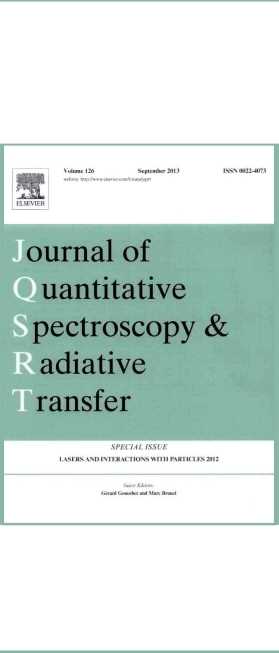
|
Registration
-
- Important dates
- Registration fees
- Register
- Early registration opens...........................January 3rd, 2022
- Late registration after...............................May 27th, 2022
In-person participation: there are 3 categories for the registration fees (in Euros, all taxes included) and they depend whether it is an early or / late registration:
- Student (Master, Ph.D)(1,2).....: 400/475
- Academic & industry(1,2)........: 500/575
- Accompanying person(1,3).....: 220/220
Polish Academy of Sciences, who hosts the conference, we can not accept the contributions (both in-person and remote) from
(1) Registrations cancelled before July 22th, 2022, will be refunded 50% of the registration fees. Registrations cancelled after this date will not be eligible for a refund.
(2) Academic/industry/student registration fee includes: the Conference attendance, book of the conference abstracts and other common conference materials, lunches and coffee breaks mentioned on the program, LIP 2022 excursion, welcome reception and social dinner.
(3) Accompanying person registration fee includes: lunches mentioned on the program, LIP 2022 excursion, welcome reception and social dinner.
(4) As a participation to guest travel, video conferencing licensing and editing and web site maintenance costs.
Practical
-
- Conference venue
- Transportation
- Accommodation
- About the city and the region
The conference venue is the Institute of Physics, Polish Academy of Sciences. It is located in the south part of Warsaw in Mokotów district, within 15 minutes by car or bus from "Chopin Airport” – the main airport of Warsaw. Institute is also about 20 – 25 min by tram or bus from the city centre and about 15 min walking distance from the metro line 1 providing convenient connection across Warsaw. Within 5 min walk from the Institute there is also a large shopping mall called “Galeria Mokotów” where several restaurants are located. In the nearest area of the Institute a few hotels can be found.
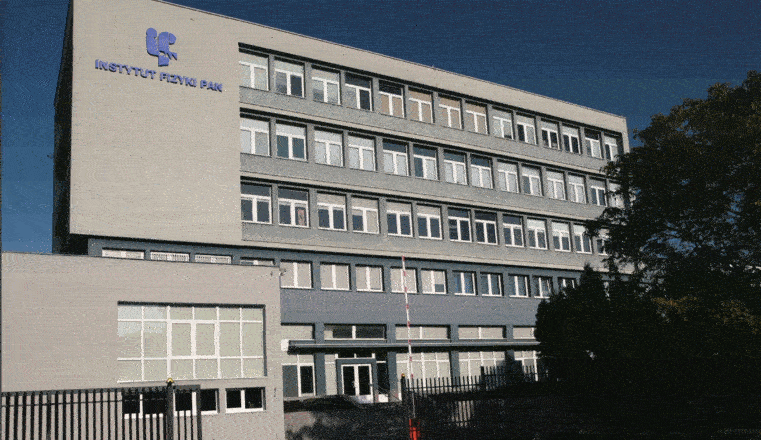
|
|
From the
International Warsaw Chopin Airport (WAW)
Every 30 min from 6h00 to 23h00 a local train departs to Warsaw central station 'Warszawa Centralna'. It takes about 25 minutes and costs about 1 €. There are also several public buses available. Convenient connection to the city centre (Centrum) is provided by bus no. 175 (departure every 20 min). Single ticket costs about 1 €. At the airport you will also find many taxis and car rental companies to bring you to Warsaw centre.
To reach the Institute of Physics, Polish Academy of Sciences, you can take taxi (cost about 5-7 €) or indirect bus connection (one change needed). For example bus no. 175 with change to the bus no. 317 at the stop “Komitetu Obrony Robotników” or with change to the bus no. 189 at the stop “Sasanki”. The destination bus stop is “Instytut Fizyki”.
Currency (August 2022
Polish currency is zloty (Polish: złoty).
Currency acronym is PLN.
Average exchange rate: 1 PLN = 0.22 EUR = 0.26 USD = 1.69 CNY / 1 EUR = 4.55 PLN = 1.19 USD = 7.67 CNY
Every 30 min from 6h00 to 23h00 a local train departs to Warsaw central station 'Warszawa Centralna'. It takes about 25 minutes and costs about 1 €. There are also several public buses available. Convenient connection to the city centre (Centrum) is provided by bus no. 175 (departure every 20 min). Single ticket costs about 1 €. At the airport you will also find many taxis and car rental companies to bring you to Warsaw centre.
To reach the Institute of Physics, Polish Academy of Sciences, you can take taxi (cost about 5-7 €) or indirect bus connection (one change needed). For example bus no. 175 with change to the bus no. 317 at the stop “Komitetu Obrony Robotników” or with change to the bus no. 189 at the stop “Sasanki”. The destination bus stop is “Instytut Fizyki”.
Currency (August 2022
Polish currency is zloty (Polish: złoty).
Currency acronym is PLN.
Average exchange rate: 1 PLN = 0.22 EUR = 0.26 USD = 1.69 CNY / 1 EUR = 4.55 PLN = 1.19 USD = 7.67 CNY
The Organizing Committee has selected a variety of accommodation around the Institute of Physics, Polish Academy of Sciences and provide necessary information in the future. We recommend to book hotel in the proximity to the institute (see map). However, number of hotels can be also found in the city centre. Convenient transport to the Institute is provided by tram, buses and metro (line no. 1, station: Wilanowska).
Higher resolution map or Google map (link)
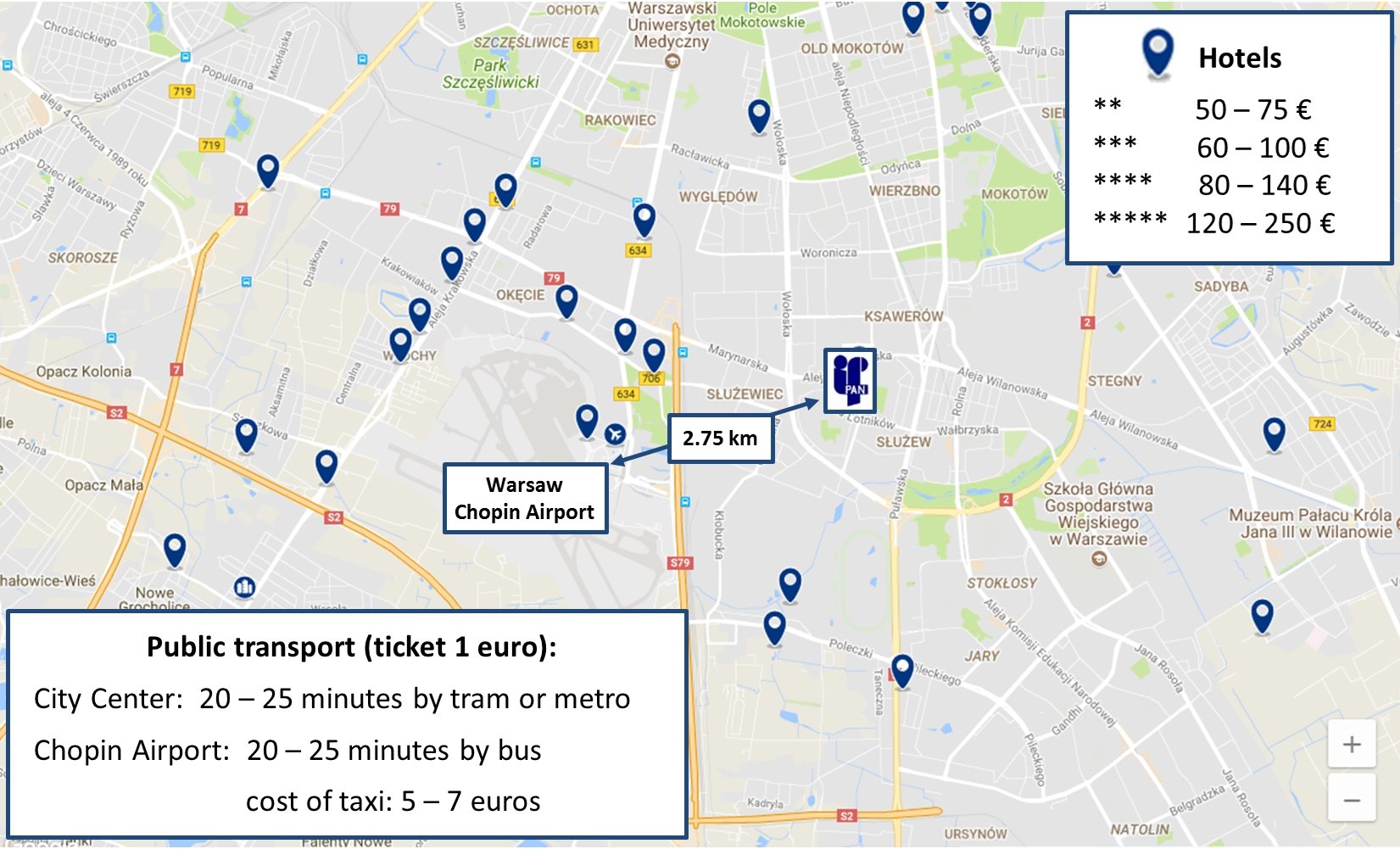
|
 |
Centrum Barnabitów ***
ul. Smoluchowskiego., 02-679 Warsaw Tel. +48 22 543 20 01/02 Distance to IF PAN: 600 m Price starts at 170 PLN Special discount available by providing thecode “LIP2022” before the payment. Booking |
||
 |
Hampton by Hilton
Warsaw Mokotów *** ul. Postepu 7, 02-676 Warsaw tel./fax: +48 22 419 77 77/76 Distance to IF PAN: 1.2 km Price starts at 230 PLN Booking |
||
 |
Vienna House Mokotów
Warsaw **** ul. Postępu 4, 02-676 Warsaw tel.: +48 22 6 889 889 e-mail: info.mokotow-warsaw@viennahouse.com Distance to IF PAN: 1.4 km Price starts at 250 PLN Booking |
||
 |
Airport Hotel Okęcie
**** ul. 17-ego stycznia 24, 02-148 Warsaw Tel.: +48 22 456 80 00 e-mail: rezerwacja@airporthotel.pl Distance to IF PAN: 2.1 km Price starts at 290 PLN Booking |
||
 |
Sangate Hotel Airport
*** ul. 17-go stycznia 32, 002-148 Warsaw tel. +48 22 576 45 50 e-mail: rezerwacje@sangate-hotel.pl Distance to IF PAN: 2.3 km Price starts at 190 PLN Booking |
||
 |
Four Points by
Sheraton Warsaw Mokotow **** Suwak 7B, Mokotów, 02-676 Warszawa Tel.: +48 22 263 66 00 Distance to IF PAN: 3.8 km Price starts at 300 PLN Booking |
||
 |
Renaissance Warsaw
Airport Hotel ***** ul. Żwirki i Wigury 1H, 00-906 Warsaw Tel.: +48 22 164 70 00 Distance to IF PAN: 3.7 km Price starts at 390 PLN Booking |
||
 |
Courtyard by Marriott
Warsaw Airport **** ul. Żwirki i Wigury 1, 00-906 Warsaw Tel.: +48 22 650 01 00 Price starts at 300 PLN Distance to IF PAN: 3.8 km Booking |
||
- “Price starts at…”: lowest price for a single room with breakfast.
- Remark: there are many apartments to rent available in the nearest proximity of the Institute of Physics PAS. Please, use Booking.com or Google Maps to find convenient place for you.
About the
city Warsaw (Polish: Warszawa) is the
capital and largest city of Poland with population
about 1.77 million residents within a greater
metropolitan area of 3.1 million, which makes Warsaw
the 8th most-populated capital city in the European
Union. Warsaw is an global city, a major
international tourist destination, and a significant
cultural, political and economic hub. Its historical
Old Town was inscribed at the UNESCO World Heritage
List.
Getting around in Warsaw
You can use buses, trams and subway (recommended) from the public transport company called "ZTM". From the company website (www.ztm.waw.pl) you can download several maps for subway and trams. However, to find connection it is more convenient to use www.jakdojade.pl/warszawa website. Dedicated mobile application (JakDojade) for Android and iOS is also available. Tickets for public transport can be purchased by application or using ticket machines inside all buses. To reach Institute of Physics Polish Academy of Sciences, choose destination stop: "Instytut Fizyki or Galeria Mokotów".
Getting around in Warsaw
You can use buses, trams and subway (recommended) from the public transport company called "ZTM". From the company website (www.ztm.waw.pl) you can download several maps for subway and trams. However, to find connection it is more convenient to use www.jakdojade.pl/warszawa website. Dedicated mobile application (JakDojade) for Android and iOS is also available. Tickets for public transport can be purchased by application or using ticket machines inside all buses. To reach Institute of Physics Polish Academy of Sciences, choose destination stop: "Instytut Fizyki or Galeria Mokotów".
Contacts
- Secretariat of the Conference
- Images & photos credits
- Last update
| |
Dr Anastasiya DERKACHOVA Institute of Physics Al. Lotnikow 32/46 02-668 Warsaw, Poland tel.: (+48) 22 116-32-77 mobile: (+48) 514-628-350 |
Dr Mariusz WOZNIAK PIT-RADWAR S.A. Poligonowa 30, 04-051 Warsaw, Poland tel.: (+48) 22 540 22 00 mobile: (+48) 693-087-455 |
Photographic
credits: thanks to Daniel Jakubczyk, Onofrio
Maragò, Loïc Méès, Fabrice Lamadie, Fabrice
Onofri, Bernard Pouligny, Kuan Fang Ren &
Mariusz Wozniak.
Contact: fabrice.onofri@univ-amu.fr
